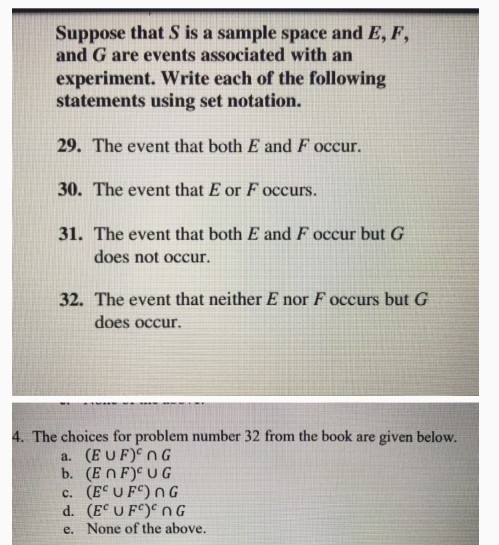QQuestionAnatomy and Physiology
QuestionAnatomy and Physiology
Suppose that $S$ is a sample space and $E, F$, and $G$ are events associated with an experiment. Write each of the following statements using set notation.
29. The event that both $E$ and $F$ occur.
30. The event that $E$ or $F$ occurs.
31. The event that both $E$ and $F$ occur but $G$ does not occur.
32. The event that neither $E$ nor $F$ occurs but $G$ does occur.
4. The choices for problem number 32 from the book are given below.
a. $(E \cup F)^{c} \cap G$
b. $(E \cap F)^{c} \cup G$
c. $\left(E^{c} \cup F^{c}\right) \cap G$
d. $\left(E^{c} \cup F^{c}\right)^{c} \cap G$
e. None of the above.
Attachments

6 months agoReport content
Answer
Full Solution Locked
Sign in to view the complete step-by-step solution and unlock all study resources.
Step 1: The event that both E and F occur.
In set notation, this is represented as the intersection of events E and F, which is expressed as E ∩ F.
Step 2: The event that E or F occurs.
In set notation, this is represented as the union of events E and F, which is expressed as E ∪ F.
Final Answer
a. (E ∪ F)^c ∩ G: This option does not represent the correct set notation since it represents the event that G does not occur and either E or F does not occur. b. (E ∩ F)^c ∪ G: This option does not represent the correct set notation since it represents the event that at least one of E, F, or G does not occur. c. (E^c ∪ F^c) ∩ G: This option correctly represents the set notation for the event that neither E nor F occurs but G does occur. d. (E^c ∪ F^c)^c ∩ G: This option does not represent the correct set notation since it represents the event that at least one of E or F must occur and G does occur. e. None of the above: This is the correct answer as none of the given options correctly represent the set notation for the event that neither E nor F occurs but G does occur.
Need Help with Homework?
Stuck on a difficult problem? We've got you covered:
- Post your question or upload an image
- Get instant step-by-step solutions
- Learn from our AI and community of students